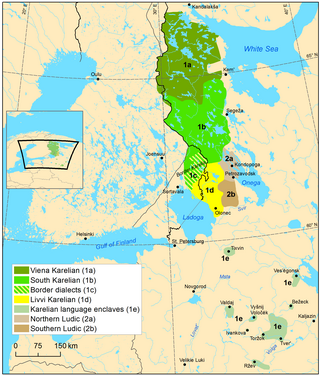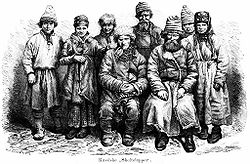
Ingrian, also called Izhorian, is a Finnic language spoken by the Izhorians of Ingria. It has approximately 70 native speakers left, most of whom are elderly.

Livvi-Karelian is a supradialect of Karelian, which is a Finnic language of the Uralic family, spoken by Olonets Karelians, traditionally inhabiting the area between Ladoga and Onega lakes, northward of Svir River.

Komi, also known as Zyran, Zyrian or Komi-Zyryan, is the native language of the Komi (Zyrians). It is one of the Permian languages; the other regional variety is Komi-Permyak.

Udmurt is a Permic language spoken by the Udmurt people who are native to Udmurtia. As a Uralic language, it is distantly related to languages such as Finnish, Estonian, Mansi, Khanty, and Hungarian. The Udmurt language is co-official with Russian within Udmurtia.

Ludic, Ludian, or Ludic Karelian, is a Finnic language in the Uralic language family or a Karelian dialect. It is transitional between the Olonets Karelian language and the Veps language. It is spoken by 300 Karelians in the Republic of Karelia in Russia, near the southwestern shore of Lake Onega, including a few children.

Nenets is a pair of closely related languages spoken in northern Russia by the Nenets people. They are often treated as being two dialects of the same language, but they are very different and mutual intelligibility is low. The languages are Tundra Nenets, which has a higher number of speakers, spoken by some 30,000 to 40,000 people in an area stretching from the Kanin Peninsula to the Yenisei River, and Forest Nenets, spoken by 1,000 to 1,500 people in the area around the Agan, Pur, Lyamin and Nadym rivers.

The Mordvinic languages, also known as the Mordvin, Mordovian or Mordvinian languages , are a subgroup of the Uralic languages, comprising the closely related Erzya language and Moksha language, both spoken in Mordovia.

The Permic or Permian languages are a branch of the Uralic language family. They are spoken in several regions to the west of the Ural Mountains within the Russian Federation. The total number of speakers is around 950,000, of which around 550,000 speak the most widely spoken language, Udmurt. Like other Uralic languages, the Permic languages are primarily agglutinative and have a rich system of grammatical cases. Unlike many other agglutinative languages, they do not have vowel harmony.

Khanty, previously known as Ostyak, is a Uralic language family composed of multiple dialect continuua, varyingly considered a language or a collection of distinct languages, spoken in the Khanty-Mansi and Yamalo-Nenets Okrugs. There were thought to be around 7,500 speakers of Northern Khanty and 2,000 speakers of Eastern Khanty in 2010, with Southern Khanty being extinct since the early 20th century. The number of speakers reported in the 2020 census was 13,900.

The Mansi languages are spoken by the Mansi people in Russia along the Ob River and its tributaries, in the Khanty–Mansi Autonomous Okrug, and Sverdlovsk Oblast. Traditionally considered a single language, they constitute a branch of the Uralic languages, often considered most closely related to neighbouring Khanty and then to Hungarian.

Selkup is the language of the Selkups, belonging to the Samoyedic group of the Uralic language family. It is spoken by some 1,570 people in the region between the Ob and Yenisei Rivers. The language name Selkup comes from the Russian селькуп, based on the native name used in the Taz dialect, шӧльӄумыт әты. Different dialects use different names.

The Finnic or Baltic Finnic languages constitute a branch of the Uralic language family spoken around the Baltic Sea by the Baltic Finnic peoples. There are around 7 million speakers, who live mainly in Finland and Estonia.

Mator or Motor is an extinct Uralic language belonging to the group of Samoyedic languages, extinct since around 1839. It was spoken in the northern region of the Sayan Mountains in Siberia, close to the Mongolian north border. The speakers of Mator, Matorians or Mators, lived in a wide area from the eastern parts of the Minusinsk District (okrug) along the Yenisei River to the region of Lake Baikal. Three dialects of Mator were recorded: Mator proper as well as Taygi and Karagas. Mator was influenced by Mongolic, Tungusic and Turkic languages before it went extinct, and may have even been possibly influenced by the Iranic languages. It went extinct as a result of the Mator people shifting linguistically to the related Kamas language or nearby Altaic-sprachbund languages, like Buryat, Soyot, Khakas, Evenki and Tatar.

Skolt Sámi is a Sámi language that is spoken by the Skolts, with approximately 300 speakers in Finland, mainly in Sevettijärvi and approximately 20–30 speakers of the Njuõʹttjäuʹrr (Notozero) dialect in an area surrounding Lake Notozero in Russia. In Norway, there are fewer than 15 that can speak Skolt Sámi ; furthermore, the language is largely spoken in the Neiden area. It is written using a modified Roman orthography which was made official in 1973.

Neiden is a village area in the Sápmi area along the Finland–Norway border with about 250 inhabitants. Neiden, situated along the Neiden River, actually consists of two villages 12 kilometers apart, separated by the border of Norway and Finland. One village is in Sør-Varanger Municipality in Finnmark county, Norway, and the other village is in Inari Municipality in Lapland, Finland. Neiden is the official name in Norway and Näätämö in Finland. The European route E6 highway runs through the Norwegian village of Neiden. The village on the Finnish side is close to the border and has border shops.

Forest Nenets is a Samoyedic language spoken in northern Russia, around the Agan, Pur, Lyamin and Nadym rivers, by the Nenets people. It is closely related to the Tundra Nenets language, and the two are still sometimes seen as simply being dialects of a single Nenets language, despite there being low mutual intelligibility between the two. The next closest relatives are Nganasan and Enets, after them Selkup, and even more distantly the other Uralic languages.

Eastern or Konda Mansi is an extinct member of the Mansi languages, and was spoken in Russia in the Khanty–Mansi Autonomous Okrug around the river Konda. It became extinct in 2018, when its last speaker Maksim Shivtorov died. It has Khanty and Siberian Tatar influence. There is vowel harmony, and for it has, frequently diphthongized.

Hungarian has ten dialects. These are fully mutually intelligible, and do not differ significantly from standard Hungarian except for the Csángó dialect. They are mostly distinguished by pronunciation; although there are differences in vocabulary, these are usually small and do not hinder intelligibility. Due to increased internal migration and urbanization during the 20th century, most of the characteristics of the different dialects can only be observed in smaller towns and villages, and even there mostly among the elderly; the population of the larger cities and especially the capital has been mixed for generations and the dialectal differences have been lost. A notable exception is the Western Transdanubian pronunciation, which is distinctly noticeable even in Szombathely, the largest city in the region.

Southern or Tavda Mansi is an extinct Uralic language spoken in Russia in the Sverdlovsk. It was recorded from an area isolated from the other Mansi varieties along the river Tavda. Around 1900 a couple hundred speakers existed; in the 1960s it was spoken only by a few elderly speakers, and it has since then become extinct. It had strong Tatar lexical influence and displayed several archaisms such as vowel harmony, retention of, , and.

Western Mansi was described as "probably extinct" in 1988. Although the last speaker is not known, none were left by the end of the 20th century. It had strong Russian and Komi influences; dialect differences were also considerable. Long vowels were diphthongized.


















